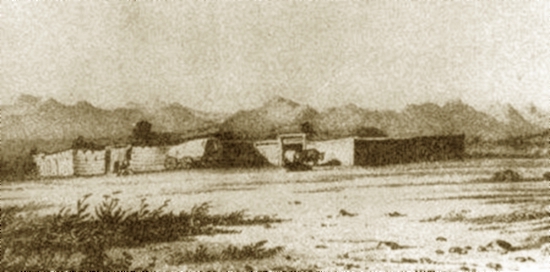
1849 view of Ft. Bridger, Stansbury Expedition
Capt. (Brevet Lt. Col.) Howard Stansbury in his report (Lippencott, Grambo & Co., Philadelphia, 1855) of his exploratory expedition to Salt Lake, described the
location and appearance of Fort Bridger:
Saturday, August 11. -- Ther. at 6 o'clock, 40 [degrees]. A drive
of thirty-two miles, during which we crossed Ham's Fork and Black's Fork three
times, brough us to Fort Bridger -- an Indian trading-post, situated on the latter stream, which here branches into three principal
channels, forming several extensive islands, upon one of which the fort is placed.
It is built in the usual form of pickets, with the lodging apartments and offices opening into
a hollow square, protected from attack from without by a strong gate of
timber. On the north, and continous with the walls, is a strong high picket-fence,
enclosing a large yard, into which the animals belonging to the establishment are
driven for protection from both wild beasts and Indians. We were received with great
kindness and lavish hospitality by the propriator, Major James Bridger, one of the
oldest mountain-men in this entire region, who has been engaged in the
Indian trade, here, and upon the heads of the Missouri and Columbia, for the
last thirty years. Several of my wagons needed repair, the train was detained five days, for the prupose, Major Bridger courteously placing
his blacksmith-shop at my service.
Fort Bridger, as the case of Fort Laramie and as indicated by the photos on this and the
next pages, had three distinct periods, (a.) a privately owned and operated
facility, established in 1843 by Jim Bridger and Louis Vasquez; (b.) a military post; and (c.) a partially restored
museum.
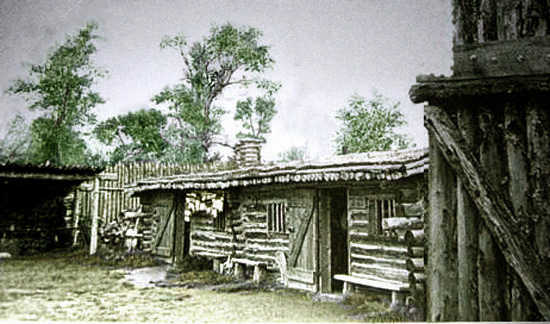
Iinterior view stockade reconstructed Fort Bridger.
Louis Vasquez, more properly Pierre Luis Vasquez, (1798-1868), was the son of Benito Vasquez of St. Louis. The elder
Vasquez had come to St. Louis to assist in the laying out of forts for the Spanish Crown and became a prominent
merchant in St. Louis, Indian trader with Indians in Kansas. The elder Vasquez was designated as a ayudante major; that is, an adjudant major with the powers of
a major in the absence of the more senior officer. He was apparently very well off financially until he invested with others in
a company for the purpose of exploration of the Upper Missouri. The Spanish, however, had difficulties in competing with
the British who had better trade goods. To off-set this he and others contibuted to a fund to provide gifts to
the Indians. Benito Vazquez contributed the same sun as Manuel Lisa, 25 libras of pelts of a value of ten pesos. That the elder
Vasquez was well off is demonstrated by his contribution to the old St. Louis cathedral of a bell.
In order to "sweeten the tone," two hundred Spanish dollars were melted down and included as a part of the alloy from which the bell was cast.
Many of those who invested in the exploration company lost their investment and came to financial grief. Benito Vasquez may have been one. In
1800, his sons petitioned the Governor for relief:
"To Don Carlos Dehault Delassus, Lieutenant Governor of Upper Louisiana"
"SIR -- Benito, Antoine, Hypolite, Joseph, and Pierre Vasquez, all of them sons of Don Benito Vasquez, captain of militia of this town, brevetted by his Catholic Majesty, full of confidence in the generosity and benevolence of the government under which they are born, hope that you will be pleased to take into consideration the unfortunate situation in which they find themselves by the want of means of their family, which has been living for some time in distressing circumstances, and unable to give them the necessary education; therefore, wishing to procure to themselves, in the course of time, an independent existence, they think of forming an establishment which may one day insure their welfare. They flatter themselves, sir, that the services of their father will assure to them your protection, and the goodness of your heart will lead you to grant their demand; consequently they supplicate you to grant to each of them eight hundred arpens of land, in superficie, making altogether the quantity of four thousand arpens, which they wish to take in one or several places of the vacant lands of the King's domain. Favor which your petitioners presume to hope from your justice."
"BENITO VASQUEZ"
"ANTOINE VASQUEZ"
"HYPOLITE VASQUEZ"
"JOSEPH VASQUEZ"
"PIERRE VASQUEZ"
"St. Louis, February 16, 1800">
"St. Louis of Illinois, February 17, 1800"
Governor Delassus granted each of the brothers the 800 arpens of land at Three Springs. An arpen is equal to about
five-sixths of an English acre. Certainly, the brothers may have an influence with the Governor.
Antoine served as secreary to Governor Delassus as well as to Governor Trudeau. Unfortunately, for those who
purchased the interests of the brothers in the Royal grant, the surveyor failed to survey the property and in 1850 the
grants were held by the United States Supreme Court to be invalid.
Left, Louis Vasquez . . .
Right, Jim Bridger
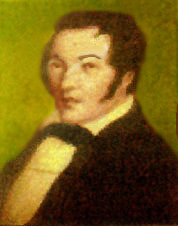

Benito the younger, known as "Baronet," served as a guide and interpreter to Zebulon Pike in his
exploration of Colorado. Pierre Luis sold his interest in the land at Three Springs and became
a partner with Andrew Sublette in the establishment of Fort Vasquez which was located on the
South Platte in present-day Weld County, Colorado. The two parnters sold the fort just as the
fur trade was ending and their two purchasers went bankrupt leaving Vasquez and Sublette holding a worthless note
for $800.00.
Vasquez continued to maintain an interest in the fur trade and in 1851 accompanied by his wife attended the conclave at the confluence of
Horse Creek and the North Platte, later to be known as the "Great Smoke." The idea for the conclave at which
the 1851 Horse Creek Treaty was negotiated was that of Thomas Fitzpatrick. The idea was to avert war on the
Great Plains. Robert Campbell, now rich, politically connected, and growing older, lobbied Congress to
support the conclave. Congress appropriated one hundred thousand dollars for gifts to the Indians. Indian Superintendent
David Mitchell solicited sealed bids for the annuities to be given the Inidans. Both Campbell and
P. Chouteau submitted bids. The War Department gave the contract to a New York company before the bids were even
received. Campbell yelled foul and as a concillation prize was appointed as one of the commissioners and given a contract
to sell beef to Fort Laramie. Campbell took his steamboat with carriage on board to Fort Laramie and arrived at the
conclave and travelled from Fort Laramie to the treaty grounds at Horse Creek in the carriage with
Father Pierre DeSmet. Father DeSmet had travelled to Fort Larmaie from Fort Union. At the conclave, Father DeSmet sanctified
Vasquez's marriage. Jim Bridger with the
Shoshones precluded violence when two of their warriors were killby by Cheyennes by promising many gits. An estimated
6,000 to 12,000 Indians attended the conclave. Hugo John Hoppe, first Sheriff of Custer County, Montana, recalled
that there was a peculiar armona at the
conclave "which is not easy to describe for it was an oder distinctly Indian – not unclean
but rather the result of constant cooking of meat; the close proximity of ponies and dogs
and the none-to-careful disposal of refuse."
For a period of time, Vasquez lived at Fort Bridger. It appears likely that much of the business operations
for the enterprise were conducted by Vasquez. Contrary to Bridger who could not read nor write, Vasquz was well educated and
reputedly spoke seven lanquages. Nevertheless,
by 1855 he was back in St. Louis where he operated a store. He also financed a dry goods and grocery store in Denver for his newphew, Auguste "Pike" Vasquez (1813-1869)
Pike was a son of
Antoine. The store was on the present site of a University of Colorado Denver soccer field.
Pike had worked for his uncle at Fort Vasquez and on the recommendation of Jim Bridger acted as a guide for
Sir St. George Gore on his famous hunting expedition. On the expedition, Pike successfully was able to replace
Gore's horse which had been lost to Inidans.
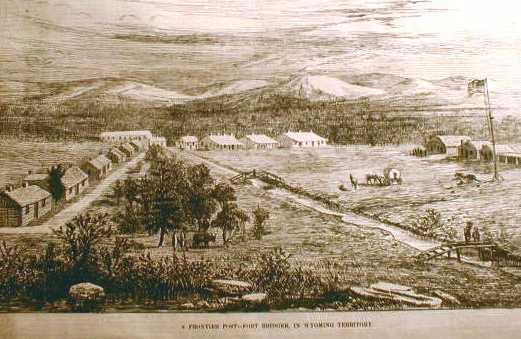
Fort Bridger, 1873, woodcut, N.Y. Daily Graphic, June 16, 1873
The original Bridger and Vasquez "fort" was described by an early traveller:
This fort is owned by Bridger and Basquez. [sic] It is built of poles and
dogwood Mud. It is a shabby concern. There are about twenty five lodges of
Indians or rather white trapper lodges occupied by their Indian wives. They
have a good supply of robes, dressed deer, elk, and antelope skins, coats,
pants, moccasins, other Indian fixins which they trade low for flour, pork,
powder, lead, blankets, butcher knives, spirits, hats, ready made clothes,
coffee, sugar, etc. They have a herd of cattle, twenty or thirty goats,
and some sheep.
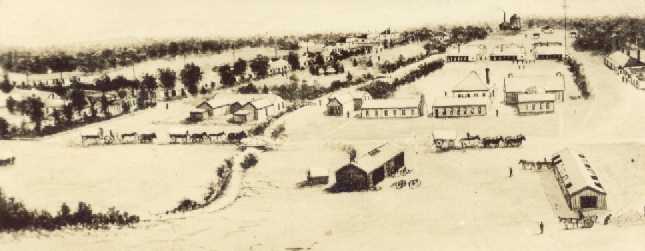
Ft. Bridger, 1889
One emigrant, Edwin Bryant, described it during its early years: "The buildings are two or three miserable
log cabins, rudely constructed and bearing
but a faint resemblance to habitable houses."
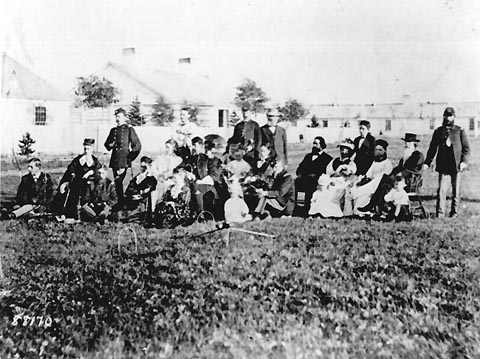 Ft. Bridger, Wyo., 1873. The post trader,
William A. Carter, in civiliam hat and beard, is seated at right side of photo.
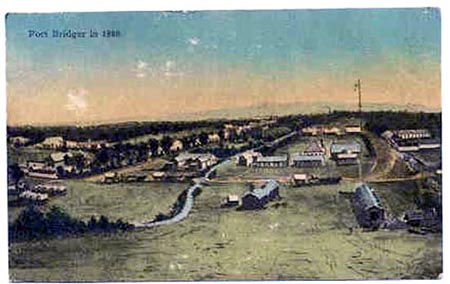 Fort Bridger, 1888
Fort Bridger, 1888
The original fort was burned down during the Mormon War in 1857, along with Ft. Supply 12 miles to the Southwest, by
the L.D.S. The Mormons claimed, over Bridger's denials, they had purchased the fort from Vasquez. The Fort was assumed
by the military under Albert Sidney Johnston in 1858, photo lower left. There was a deed dated August 3, 1855, recorded October 21, 1858, in
Salt Lake City in Records Book B. p. 128 that ostensibly sold Fort Bridger to the Mormon Church. Bridger and
Vasquez's name was signed by H. F. Morrell in the presence of Alinerin Grow and William A. Hickman, purportedly pursuant to a power of attorney.
It should be noted, however, that in order for a power of attorney authorizing the sale of land to be valid, it is necessary that it be executed with the
same formalities as a deed, a doctrine in law known as the "equal dignities rule." Since the time of Henry VIII deeds have
been required to be in writing and signed by the maker. Thus, the purported power of attorney would have
been required to be in writing and signed by Vasquez and Bridger. It has been observed that Bridger was absent from the
area in 1855. He was acting as guide for Sir St. George Gore. Accordingly, absent a signed power of attorney from Bridger, it is extremely doubtful that the
purported deed, if challenged, was worth the paper it was written upon.
On the other hand, it has been contended that Jim Bridger out foxed the Mormons. Professor Countant cites in his work a report by E. A. Curley, a special
correspondent for the London Field. who contended that Bridger had no title at all but nevertheless succeeded in convincing
"President Brigham Young--who was even than an old bird not easily caught--that he bout out Bridger, who pretended to hold a stretch of thirty miles under
a Mexican grant, paying him down $4,000 for the grant, the shanties and the cattle, and agreeing to pay $4,000 more at a
subsequent time. The place became too hot for the Mormons; they had to leave, and Bridger rented his
pretended grant to General A. S. Johnston of a military post for $600 a year, on a ten years' lease. Taking a copy of this provisional lease, he then journeyed to Salt Lake and
succeeded in raising the other $4,000 from the Mormon prophet."
But Curley continued, a search revealed that there was no Mexican grant and that "Bridger was
kindly obliging the government for a substantial consideration with a piece of its own property."
The government of course failed to pay Bridger but "old Jim had the pleasure of spending the $8,000."
Countant contends that Curley;s source was the post-sutler, W. A. Carter. Countant, however, points out that
the War Department believed that Bridger had good title since he settled prior to American acquisition of the area. Countant
argues "All of Bridger's transactions were notably honest, and there are hundreds of people even to this day, who knew him well, and who will testify to this."
Countant, pp 351-352.
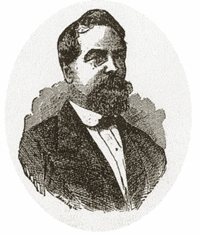 William A. Hickman
William A. Hickman
Hickman, if his later autobiography is to be believed, could best be charitably described as Brigham Young's
"hitman." Hickman, a personal assistant to President Young, allegedly killed 54 men on the direct orders of
Young. After his excommunication from the Church in 1868, Hickman's testimony resulted in the
indictment of Young as an accessory to the murder of Richard Yates. Young never stood trial in that in
another case, Clinton v. Englebrecht, 80 U.S. 434 (1871),
the United States Supreme Court determined that jurors had been
improperly summoned. Thus, the indictment was a nullity. Over 100 pending criminal cases, including the
cases against Hickman and Young were dismissed. Hickman after writing his 1872 autobiography, Brigham's Destroying Angel, was ostracized by Mormon and
Gentile alike, and died, abandoned by all but his first wife and a few of his 35 children, in a sod dugout near Lander on
August 21, 1883.
Next page: Fort Bridger continued, The Mormon War.
|